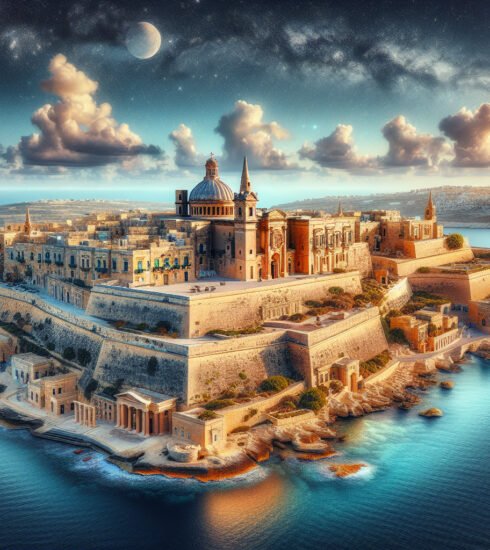Unearthing Maltas Enigmatic Pathways to the Past: A Fascinating Article on Footsteps of History
Introduction
Welcome to Malta, a small and picturesque Mediterranean island with a rich and mysterious history. From the towering megalithic temples to the fortified cities, this island is a treasure trove of archaeological wonders that have captivated historians, archaeologists, and tourists alike. In this article, we will take you on a journey through the footsteps of history, uncovering the enigmatic pathways to the past that exist in Malta.
Mysterious Malta: Unveiling the Ancient Ruins
Malta is home to some of the most well-preserved and awe-inspiring ancient ruins in the world. These structures offer a glimpse into the past, providing valuable insights into the lives and cultures of the people who inhabited this island thousands of years ago. Let’s explore some of the most mysterious and fascinating historical sites in Malta.
The Megalithic Temples
The Megalithic Temples of Malta are UNESCO World Heritage Sites and are among the oldest freestanding structures in the world, predating the pyramids of Egypt. These temples, such as the Ġgantija Temples in Gozo and the Ħaġar Qim and Mnajdra Temples in Malta, were built between 3600 and 2500 BCE. They are a testament to the advanced engineering skills and complex religious beliefs of the prehistoric people who constructed them.
These temples were built using colossal stone blocks, often weighing several tons, which were quarried from nearby locations. The precise construction techniques employed by the ancient builders still puzzle experts today. The purpose of these temples remains a mystery, with theories ranging from religious ceremonies to astrological observatories.
If you want to delve deeper into the mysteries of the Megalithic Temples, I recommend reading this article available at Malta Trip. It provides a comprehensive overview of these remarkable structures.

The Hypogeum of Ħal-Saflieni
Another fascinating historical site in Malta is the Hypogeum of Ħal-Saflieni, a subterranean complex that dates back to around 4000 BCE. This underground temple, located in Paola, was accidentally discovered in 1902 and has been hailed as a unique archaeological find.
The Hypogeum consists of chambers and passageways carved into the soft limestone bedrock. The most famous chamber, known as the “Oracle Room,” features a series of carved niches and an acoustic phenomenon that allows whispers to be heard throughout the chamber.
Due to its delicate nature and the need for preservation, access to the Hypogeum is limited to a small number of visitors each day. It’s advisable to book your visit well in advance to secure a spot to explore this enigmatic underground wonder.
Fortified Cities: Mdina and Birgu
Malta’s history is also marked by several fortified cities, which played a crucial role in the island’s defense throughout the centuries. Two of the most notable fortified cities are Mdina and Birgu.
Mdina, also known as the “Silent City,” is a medieval walled city located in the center of the island. With its narrow streets, impressive palaces, and magnificent cathedral, Mdina offers a captivating glimpse into Malta’s past. Walking through the city feels like stepping back in time, as you explore its historic buildings and soak in the views from the ancient city walls.
Birgu, on the other hand, is a fortified city located on the Grand Harbor. It served as the base of the Knights of St. John during the Great Siege of Malta in 1565. The city’s defensive walls, watchtowers, and fortifications are a testament to its strategic importance throughout history.

Unearthing the Secrets: Archaeological Discoveries in Malta
Archaeological research and excavations have unearthed numerous treasures and shed light on Malta’s ancient civilizations. Let’s explore some of the most significant discoveries that have provided invaluable insights into the island’s past.
The Venus of Malta
One of the most iconic archaeological finds in Malta is the Venus of Malta, a small prehistoric figure believed to represent a fertility goddess. This limestone statuette was discovered in the Hypogeum of Ħal-Saflieni and is dated to around 3000 BCE. It is the earliest known representation of the human form in Malta and is now housed in the National Museum of Archaeology in Valletta.
The Tarxien Temples
Another important archaeological site in Malta is the Tarxien Temples, located in the southeastern part of the island. These temples were constructed between 3600 and 2500 BCE and are known for their intricate stone carvings, including depictions of animals, plants, and human figures.
The Tarxien Temples Complex consists of four interconnected structures, with each temple possessing its unique architectural features. Excavation work carried out in the 20th century revealed various artifacts, including pottery, tools, and figurines, providing valuable insights into the daily lives of the temple builders.
The Enigmatic Ruins of Malta: A Window into the Past
The enigmatic ruins of Malta offer a unique opportunity to explore the island’s ancient history and unravel the mysteries of the past. From the Megalithic Temples to the Hypogeum of Ħal-Saflieni and the fortified cities of Mdina and Birgu, these historical sites transport visitors back in time and provide a deeper understanding of the island’s rich cultural heritage.
The impeccable preservation of these archaeological wonders, combined with ongoing research and excavations, ensures that new discoveries are constantly being made. Malta continues to captivate visitors with its mysterious past and leaves them with a profound appreciation for the footsteps of history that lie beneath its enigmatic pathways.






